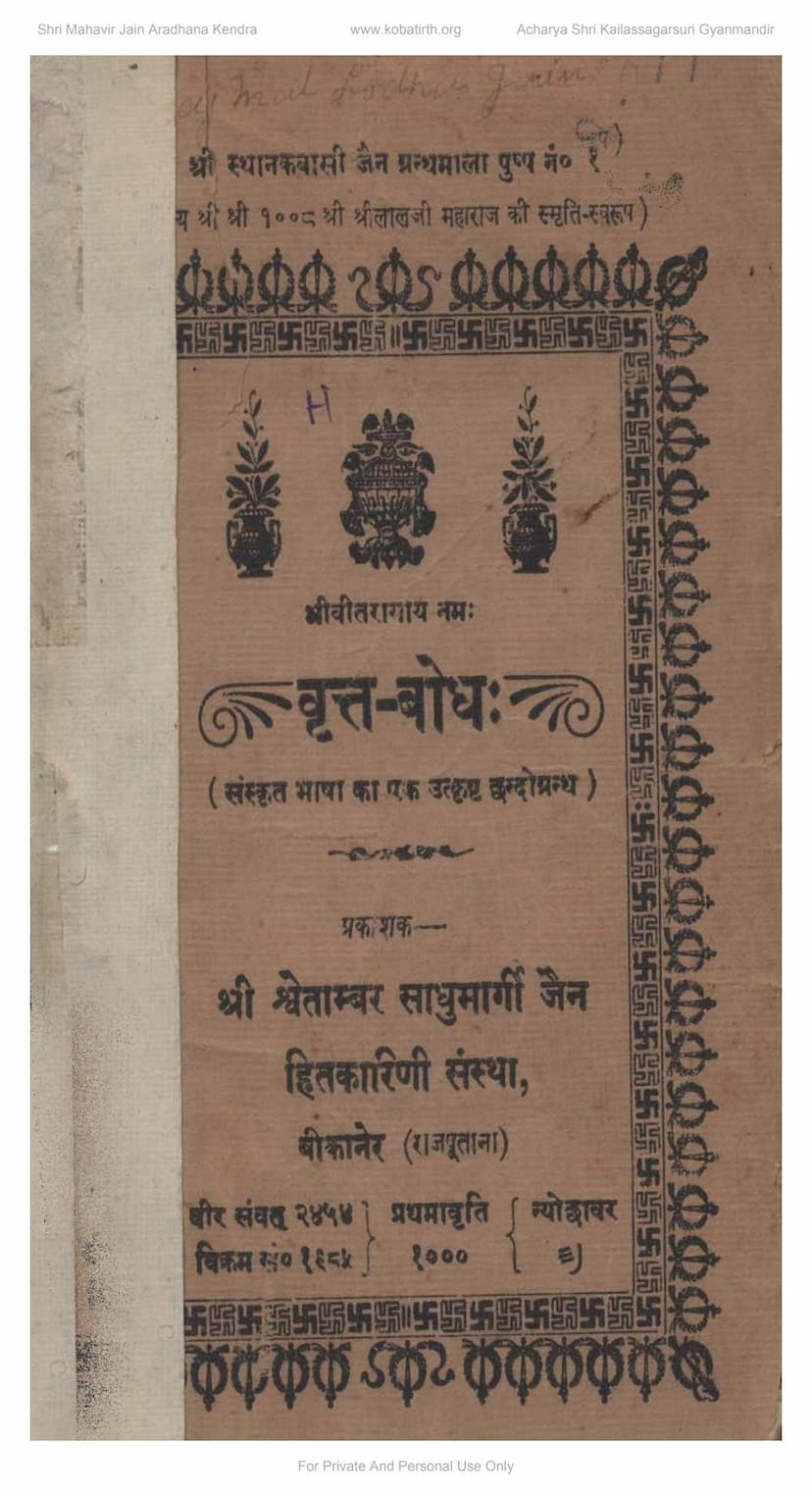Vruttabodh
Added to library: September 2, 2025

Summary
This document is a comprehensive summary of the Jain text "Vruttabodh" (वृत्तबोध), authored by the Shwetambar Sadhumargi Jain Hitkarini Samstha. The book is dedicated to the memory of Shri Lalji Maharaj.
Core Purpose and Context:
The introduction highlights a societal concern about the prevalence of eroticism ("Shringar") in literature, including poetry and prosody, which was deemed inappropriate for education, particularly for children. The text aims to provide a Sanskrit prosody (Chhandasshastra) book that is simple, clear, and suitable for educational purposes, filling a gap left by existing works that contained objectionable content. It mentions that a similar need was met in Hindi by Babu Jagannathdas 'Bhanu' with his "Chhand-Prabhakar."
Key Content and Structure:
The book is structured as a guide to various Sanskrit meters (Chhands). It begins with:
- Mangalacharan (Invocation): A prayer to Lord Jinendra, the Tirthankar.
- Purport/Purpose: Explaining the need for a simplified prosody text.
- Definitions (Paribhasha): Explaining the fundamental rules and terms.
- Guru-Laghu Vichar (Consideration of Heavy and Light Syllables): Rules for identifying long (Guru) and short (Laghu) syllables in Sanskrit, including specific rules for syllables at the end of verses, those followed by anusvara (nasalization), visarga (aspiration), or conjunct consonants, and long vowels.
- Gana Vichar (Consideration of Metric Feet): Introduction of the eight metric feet (Ganas) used in Sanskrit prosody: Bhagana (भ), Jagana (ज), Sagana (स), Yagana (य), Ragana (र), Tagana (त), Magana (म), and Nagana (न). It explains their structure in terms of Guru and Laghu syllables.
Coverage of Various Meters:
The bulk of the text meticulously defines and explains numerous Sanskrit meters, providing:
- The name of the meter.
- Its specific rules regarding the placement of Guru and Laghu syllables, often with examples or descriptions of the pattern.
- Footnotes or explanations in Hindi, clarifying the rules and sometimes providing phonetic representations or character patterns (e.g.,
(ISISISIS)).
The book covers a wide array of meters, including:
-
Anushtup (अनुष्टुभ): Defining the pattern of Guru and Laghu syllables in each line.
-
Padya (पद्य): Similar to Anushtup but with a slight variation in the seventh syllable of even lines.
-
Matra-vritti (मात्रावृत्ति - Syllable Count Based Meters):
- Arya (आर्या): Based on the number of syllables (matras) in each line.
- Giti (गीति): Related to Arya, with specific syllable counts.
- Upagiti (उपगीति): Another variation related to Arya.
-
Samakshara Chhandas (समाक्षर छन्द - Meters with Equal Syllables):
- Nagavishrini/Pramanika (नगस्वरूपिणी/प्रमाणिका): Describing the pattern of Guru and Laghu.
- Vidyunmala (विद्युन्माला): All syllables are Guru, with specific pauses.
- Shalini (शालिनी): Specifying positions of Guru and Laghu.
- Champakamala (चम्पकमाला): Detailed rules for Guru and Laghu placement.
- Rukmavati/Manibandha (रुक्मवती/मणिबन्ध): A variation of Champakamala.
- Dodhak (दोधक): Rules for Guru placement.
- Indravajra (इन्द्रवज्रा): Defining the meter with specific Ganas and pauses.
- Upendravajra (उपेन्द्रवज्रा): A variation of Indravajra.
- Upajati (उपजाति): A combination of Indravajra and Upendravajra.
- Akhyaniki (आख्यानिकी): Another combination meter.
- Rathoddhata (रथोद्धता): Specifying Ganas and pauses.
- Swagata (स्वागता): Rules for Guru and Laghu, similar to Rathoddhata in pauses.
- Totaka (टोटक): Based on Sagana Ganas with specific pauses.
- Pramitakshara (प्रमिताक्षरा): Rules related to Totaka with Guru/Laghu variations.
- Bhujangaprayata (भुजङ्गप्रयात): Based on Yagana Ganas with pauses.
- Jaloddhatagati (जलोद्धतगति): Based on Jagana, Sagana, Jagana, Magana with pauses.
- Drutavilambita (द्रुतविलम्बित): Based on Nagaya, Bhagaya, Bhagaya, Ragana.
- Harinipluta (हरिणीप्लुता): A variation of Drutavilambita.
- Vanshastha (वंशस्थ): Based on Jagana, Tagana, Jagana, Ragana with pauses.
- Indravansha (इन्द्रवंशा): A variation of Vanshastha.
- Prabhavati (प्रभावती): Based on Tagana, Bhagana, Sagana, Jagana with pauses.
- Maharshini (महर्षिणी): Detailing positions of Guru and pauses.
- Vasantatilaka (वसन्ततिलका): Based on Tagana, Bhagana, Jagana, Jagana with pauses.
- Malini (मालिनी): Rules for Laghu and Guru placement with pauses.
- Harini (हरिणी): Detailed rules for Laghu and Guru placement with pauses.
- Shikharini (शिखरिणी): Rules for Laghu and Guru placement with pauses.
- Prithvi (पृथ्वी): Rules for Guru placement with pauses.
- Mandakranta (मन्दाक्रान्ता): Rules for Guru placement with pauses.
- Hamsi (हंसी): A variation of Mandakranta.
- Shardulavikriditam (शार्दूलविक्रीडितम्): Detailed rules for Guru placement with pauses.
- Sragdhara (स्रग्धरा): Rules for Laghu and Guru placement with pauses.
- Panabandha (पणबन्ध): Rules for Laghu placement with pauses.
- Matta (मत्ता): Rules for Laghu and Guru placement.
- Manigunanikara (मणिगुणनिकर): Rules for Guru and Laghu placement with pauses.
- Kudmaladanti (कुड़मलदन्ती): Rules for Guru and Laghu placement with pauses.
- Vaishnavi (वैश्वदेवी): Rules for Laghu and Guru placement with pauses.
- Kusumavichitra (कुसुमविचित्रा): Rules for Laghu and Guru placement with pauses.
- Sragvini (स्रग्विणी): Rules for Laghu and Guru placement with pauses.
- Praharaṇakalita (प्रहरणकलिता): Rules for Guru and Laghu placement with pauses.
- Bhramaravilashita (भ्रमरविलसित): Rules for Laghu and Guru placement with pauses.
- Srak (माला) (स्रक् (माला)): Rules for Guru placement with pauses.
- Viyogini (वियोगिनी): Rules for Laghu and Guru placement in alternating patterns.
- Pushpitagra (पुष्पिताग्रा): Rules for Laghu and Guru placement in alternating patterns.
- Drutamadhya (द्रुतमध्या): Rules for Laghu and Guru placement in alternating patterns.
-
Samaptishlok (Concluding Verse): A verse stating that the author, Muni Shri Jawahirlal Acharya, with the name 'Ghasi Lal', composed this "Vruttabodh" in the year 1684 of the Veer Samvat (equivalent to 1983-84 AD), aiming to please seekers of truth and those following the Sthanakvasi tradition.
Overall Significance:
"Vruttabodh" serves as a foundational text on Sanskrit prosody specifically curated for the Shwetambar Jain community. Its primary contribution is providing a clear, accessible, and ethically sound guide to understanding and appreciating Sanskrit poetry and meter, free from the objectionable content found in some other works. The emphasis on simplicity and educational suitability makes it a valuable resource for students and scholars of Jain literature and Sanskrit poetry.